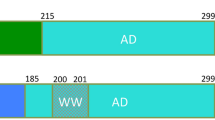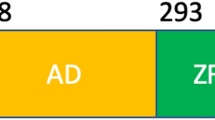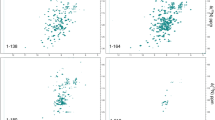Abstract
Pdcd4 (Programmed Cell Death Protein 4) is a novel eukaryotic tumour suppressor protein, which is involved in the regulation of both transcription and translation (reviewed in Lankat-Buttgereit and Göke 2009). The protein contains two interacting MA-3 domains (MA-3M and MA-3C), which are linked by a short semi-flexible linker region (Waters et al. 2007; Suzuki et al. 2008). The MA-3 domains are involved in mediating specific protein–protein interactions with functional partners such as eIF4A (Yang et al. 2003 ). Here we report essentially complete backbone and side chain 15N, 13C and 1H assignments for a construct composed of the middle MA-3 domain and subsequent linker region (MA-3M) and backbone assignments for the entire tandem MA-3 region of Pdcd4 (Pdcd4 MA-3M-C). Analysis of the backbone chemical shift data obtained indicates that Pdcd4 MA-3M contains eight helical regions corresponding to over 74% of the protein backbone and that Pdcd4 MA-3M-C contains fifteen helical regions (72%). Comparison of the position of these helical regions with those observed in the crystal structures suggests that the solution and crystal structures of both proteins are very similar.
Similar content being viewed by others
Biological context
The eukaryotic regulatory protein Pdcd4 (Programmed Cell Death Protein 4) was initially discovered in a screen for genes activated during apoptosis and later identified as a tumour suppressor in studies of a mouse keratinocyte model of tumour promotion. A number of subsequent studies have also highlighted Pdcd4’s role as a tumour suppressor, for example, Pdcd4 has been shown to suppress tumour development in a mouse model of skin carcinogenesis (reviewed in Lankat-Buttgereit and Göke 2009). Pdcd4 has been shown to play critical roles in the regulation of both transcription and translation, mediated via specific protein–protein and perhaps protein-RNA interactions (Bitomsky et al. 2004; Yang et al. 2003).
The 469 residue mouse Pdcd4 protein contains at least three domains, an N-terminal RNA-binding region (residues 1–157) and two interacting MA3 domains (residues 157–275 and 319–449), which are linked by a short semi flexible region (Waters et al. 2007; Suzuki et al. 2008). To date the majority of the molecular and structural studies of Pdcd4 have focused on the interaction between the two MA-3 domains of Pdcd4 and the eukaryotic translation initiation factor eIF4A, with complex formation resulting in the inhibition of cap-dependent translation (Yang et al. 2003). The structures of both the isolated C-terminal (MA-3C) MA-3 domain, and a construct composed of the middle MA-3 domain and subsequent linker region (MA-3M) of Pdcd4 have been solved and were shown to be composed of three or four layers of atypical HEAT repeats respectively (Waters et al. 2007; Suzuki et al. 2008). More recently, the crystal structure of the entire tandem MA-3 region (MA-3M-C) has also been determined (Loh et al. 2009). To date only the assignments for the Pdcd4 MA-3C have been deposited (BMRB accession number 6900).
Here we report the determination of essentially complete sequence-specific backbone and side chain assignments for Pdcd4 MA-3M and backbone assignments for Pdcd4 MA-3M-C, as well as the positions of elements of regular secondary structure.
Methods and experiments
Unlabelled and uniformly 15N and 15N/13C labelled samples of mouse Pdcd4 MA-3M (residues 157–318) and Pdcd4 MA-3M-C (residues 157–449) were prepared from pGex-6P-2-based E. coli expression vectors essentially as described previously for Pdcd4 MA-3C (Waters et al. 2006a), however, for Pdcd4 MA-3M-C transformed cells protein expression was induced for 20 h at 15°C. In addition, the cleaved Pdcd4 constructs and GST were separated by a second round of glutathione based affinity chromatography prior to gel filtration. A 13C labelled Pdcd4 MA-3M sample which was used for the 13C/1H NOESY-HSQC experiment was prepared as described above, but with the addition of non-isotopically labelled aromatic amino acids to the minimal media (His, Phe, Trp and Tyr at 50 mg/l).
NMR spectra of Pdcd4 MA-3M were acquired from 0.35 ml samples of 0.5–1.5 mM Pdcd4 MA-3M in a 25 mM sodium phosphate, 100 mM sodium chloride, 0.5 mM DTT, 10 μM EDTA, 200 μM AEBSF and 0.02% (w/v) sodium azide buffer at pH 6.5, containing 10% D2O/90% H2O or 100% D2O as appropriate. All NMR data were acquired at 25°C on either 600 MHz Bruker Avance/DRX systems or an 800 MHz Bruker Avance II spectrometer. The 2D and 3D spectra recorded to obtain sequence specific assignments for Pdcd4 MA-3M were: 1H-1H TOCSY with mixing times of 35 and 55 ms, 1H-1H NOESY with an NOE mixing time of 100 ms; 15N/1H HSQC; TOCSY-HSQC with a mixing time of 55 ms; NOESY-HSQC with an NOE mixing time of 100 ms; 13C/1H HCCH-TOCSY with a mixing time 19.6 ms, 13C/1H HSQC-NOESY with an NOE mixing time of 100 ms; 15N/13C/1H HNCACB, CBCA(CO)NH and HNCO (reviewed in Cavanagh et al. 2006). Typical acquisition times in F1 and F2 for the 3D experiments were 12–25 ms for 15N, 6.7–9.0 ms for 13C (35 ms for HNCO experiments) and 15–22.5 ms for 1H, and with an acquisition time of 55–70 ms in F3 (1H). Typical acquisition times in F1 for 2D experiments were 50 ms for 15N and 35 ms for 1H, with 80–100 ms in F2.
NMR spectra of Pdcd4 MA-3M-C were acquired from 0.35 ml samples of 0.15–0.50 mM Pdcd4 MA-3M-C in a 25 mM sodium phosphate, 100 mM sodium chloride, 2.5 mM DTT, 2.5 mM TCEP, 50 μM EDTA, 200 μM AEBSF, and 0.02% (w/v) sodium azide buffer at pH 6.5, containing 5% D2O/95% H2O. NMR data were acquired at 35°C on an 800 MHz Bruker Avance II spectrometer. The 3D spectra recorded to obtain backbone assignments for Pdcd4 MA-3M-C were: 15N/1H NOESY-HSQC with an NOE mixing time of 75 ms and 15N/13C/1H HNCA, HNCO, TROSY-HN(CO)CA and CBCA(CO)NH. Typical acquisition times in F1 and F2 for the 3D experiments were 10–25 ms for 15N, 6.7–9.0 ms for 13C (22.5 ms for HNCO experiments) and 16 ms for 1H, and with an acquisition time of 60 ms in F3 (1H).
The majority of the 3D spectra were collected over approximately 72 h. The WATERGATE method was used to suppress the water signal when required. The 3D NMR data were processed using Topspin (Bruker Biospin Ltd) with linear prediction used to extend the effective acquisition times by up to twofold in F1 and F2. The spectra were analysed using the Sparky package (T. D. Goddard and D. G. Kneller, SPARKY 3, University of California, San Francisco).
Sequence-specific backbone and side chain resonance assignments were obtained for Pdcd4 MA-3M using the approach described previously (Waters et al. 2006b). Initially, tentative sequence-specific backbone resonance assignments (N, NH, Cα and CO) for Pdcd4 MA-3M-C were obtained by transposing the assignments from the isolated MA-3 domains (acquired at 25°C) onto the triple resonance spectra obtained for Pdcd4 MA-3M-C (acquired at 35°C). Ambiguities between the assignments obtained for the individual MA-3 domains and Pdcd4 MA-3M-C, arising from differences in the temperature at which the spectra were recorded and/or changes in the chemical environment of residues located at the interface between the two MA-3 domains, were resolved by comparing the amide nitrogen/proton and carbonyl chemical shifts of residues in HNCO spectra recorded at a range of temperatures (25 and 35°C for the individual MA-3 domains and 25, 30 and 35°C for Pdcd4 MA-3M-C). Finally, the inter-residue amide nitrogen/proton to Cα connectivities observed in triple resonance spectra and the NH to NH NOEs identified in NOESY-HSQC spectra were used to confirm all the assignments made.
Extent of assignments and data deposition
Pdcd4 MA-3M gives rise to well-resolved spectra, as illustrated by the 15N/1H HSQC spectrum shown in Fig. 1a. This allowed essentially complete backbone resonance assignments to be made. Despite the relatively large size of Pdcd4 MA-3M-C (293 residues) and consequent overlap of signals in 2D 15N/1H HSQC spectra, we were also able to obtain comprehensive sequence-specific backbone resonance assignments. The quality of the NMR spectra obtained is illustrated by the HSQC and HNCO spectra shown in Fig. 1b, c.
Quality of the NMR spectra obtained for Pdcd4 MA-3M and Pdcd4 MA-3M-C. Panel A shows an 15N/1H HSQC spectrum of Pdcd4 MA-3M. The assignments of the signals from backbone amide groups are indicated by residue type and number. The region between 6.7 and 7.8 ppm in 1H and 110.0 and 113.3 ppm in 15N contains, with the exception of E210, S224, T229 and I273, signals from the sidechain amide groups of the asparagine and glutamine residues. The signal located at 10.0 ppm in 1H and 128.4 ppm in 15N ppm is from the indolic-NH group of W315. The assignments obtained for overlapped signals in the region between 7.7 and 8.4 ppm in 1H and 116.6 and 122.3 ppm in 15N are indicated in the enlarged region. Panel B shows an 15N/1H HSQC spectrum of Pdcd4 MA-3M-C and panel C a three dimensional view of a 15N/13C/1H HNCO spectrum of Pdcd4 MA-3M-C
Backbone amide assignments were obtained for all residues in Pdcd4 MA-3M except: D180, S214 and A291 (98.1%), for all Cα and Cβ signals apart from M218 (Cβ only), C288 and Q290 (98.5%) and for all CO signals, except for residues followed by a proline, and G179, A213, T233, Q290 and G318 (93.2%). In the case of Hα and Hβ signals, assignments were obtained for all residues except: P201, L207 (Hβ3 only), R216, E217 (Hβ2, Hβ3), M218 (Hβ3 only), K221 (Hβ3 only), P258, L260, R267, C288, Q290 and S317 (Hβ3 only) (94.1%). For the remaining non-exchangeable side chain signals (13C and 1H) complete assignments were obtained apart from: L188 ((Hδ2)3), L193 (Cγ), K197 (Hε3), P201 (Cγ, Cδ, Hγ2, Hγ3, Hδ2, Hδ3), L207 (Cγ, Hγ), R216 (Cγ, Cδ, Hγ2, Hγ3, Hδ2, Hδ3), P248 (Cγ), P258 (Cγ, Cδ, Hγ2, Hγ3, Hδ2, Hδ3), L260 (Cγ, Cδ1, Cδ2, Hγ, (Hδ1)3, (Hδ2)3), R267 (Cγ, Cδ, Hγ2, Hγ3, Hδ2, Hδ3), V269 (Cγ1), Q290 (Cγ, Hγ2, Hγ3) and W315 (Hζ2, Hη2) (93.5%).
Backbone amide assignments were obtained for all non-proline residues in Pdcd4 MA-3M-C except: D180, S214, A291, G319, H326, V328, K329, E330, I331, V356, H360, T397, D418, V419, S422 and S449 (94.0%), for all Cα signals except: H326, V328, K329, E330, V356, I415, L417, D418, V419, S422, P448 and S449 (95.9%), and for all CO signals except residues followed by a proline, and G179, A213, T233, Q290, G318, N325, L327, V328, K329, E330, E355, F359, I396, D414, L417, D418, H421, P448 and S449 (89.8%). The comprehensive 15N, 13C and 1H resonance assignments obtained for Pdcd4 MA-3M and Pdcd4 MA-3M-C have been deposited at the BioMagResBank database (accession numbers 16538 and 16542 respectively).
Analysis of the backbone chemical shifts of Pdcd4 MA-3M, using the programme TALOS (Shen et al. 2009), shows that the domain contains eight helical regions (residues E161-H178, D180-L191, E195-E210, A213-L226, T233-D253, P255-D271, N276-K283 and Q290-S305). These regions are in close agreement with the position of the secondary structure elements observed in the crystal structure of Pdcd4 MA-3M, as shown in Fig. 2a (Suzuki et al. 2008). Similarly, analysis of the backbone chemical shifts of Pdcd4 MA-3M-C showed that there were 15 helical regions (residues E161-H178, T181-L191, M196-E210, A213-L226, T233-D253, P255-D271, N276-K283, V289-S305, I331-L340, I344-E355, H360-E373, S378-S393, I398-N416, Y423-A436 and K441-D445). These results are also in close agreement with the position of the secondary structure elements observed in the crystal structure of Pdcd4 MA-3M-C, as shown in Fig. 2b (Loh et al. 2009). The one exception is the absence of the N276-K283 helix in the crystal structure, where this region is instead composed of a series of bends and turns. However, it should be noted that B-factors for this region are somewhat higher than average. The NMR results reported here clearly indicate that the solution and crystal structures of both proteins are very similar.
Location of the secondary structure elements in Pdcd4 MA-3M and Pdcd4 MA-3M-C. Panel A shows the amino acid sequence of Pdcd4 MA-3M. Highlighted in blue on the sequence are the positions of the helical regions observed in the crystal structure of Pdcd4 MA-3M (Suzuki et al. 2008: PDB code 2RG8). Indicated underneath the sequence in purple and pink are the regions suggested to be helical by the programmes TALOS (shown immediately below) and CSI respectively. Residues for which no data could be obtained, due to a lack of input chemical shifts, are highlighted in grey. Panel B shows the amino acid sequence for the entire Pdcd4 MA-3M-C region. Helical regions are indicated as in panel A. In this case, residues highlighted in blue show the positions of the helical regions observed in the crystal structure of Pdcd4 MA-3M-C (Loh et al. 2009: PDB code 3EIJ)
References
Bitomsky N, Bohm M, Klempnauer K (2004) Transformation suppressor protein Pdcd4 interferes with JNK-mediated phosphorylation of c-Jun and recruitment of the coactivator p300 by c-Jun. Oncogene 23(45):7484–7493. doi:10.1038/sj.onc.1208064
Cavanagh J, Fairbrother WJ, Palmer AG, Skelton NJ, Rance M (eds) (2006) Chapter 6: experimental 1H NMR methods and chapter 7: heteronuclear NMR experiments. In: Protein NMR Spectroscopy: principles and practice, 2nd edn. Elsevier Academic Press, Amsterdam, pp 406–673
Lankat-Buttgereit B, Göke R (2009) The tumour suppressor Pdcd4: recent advances in the elucidation of function and regulation. Biol Cell 101(6):309–317. doi:10.1042/BC20080191
Loh PG, Yang HS, Walsh MA, Wang Q, Wang X, Cheng Z, Liu D, Song H (2009) Structural basis for translational inhibition by the tumour suppressor Pdcd4. EMBO J 28(3):274–285. doi:10.1038/emboj.2008.278
Shen Y, Delaglio F, Cornilescu G, Bax A (2009) TALOS+: a hybrid method for predicting protein backbone torsion angles from NMR chemical shifts. J Biomol NMR 44(4):213–223. doi:10.1007/s10858-009-9333-z
Suzuki C, Garces RG, Edmonds KA, Hiller S, Hyberts SG, Marintchev A, Wagner G (2008) PDCD4 inhibits translation initiation by binding to eIF4A using both its MA3 domains. PNAS 105(9):3274–3279. doi:10.1073/pnas.0712235105
Waters LC, Bohm M, Veverka V, Muskett FW, Frenkiel TA, Kelly GP, Prescott A, Dosanjh NS, Klempnauer KH, Carr MD (2006a) NMR assignment and secondary structure determination of the C-terminal MA-3 domain of the tumour suppressor protein Pdcd4. J Biomol NMR 36(1):18. doi:10.1007/s10858-005-5887-6
Waters L, Yue BG, Veverka V, Renshaw P, Bramham J, Matsuda S, Frenkiel T, Kelly G, Muskett F, Carr M, Heery DM (2006b) Structural diversity in p160/CREB-binding protein coactivator complexes. J Biol Chem 281(21):14787–14795. doi:10.1074/jbc.M600237200
Waters LC, Veverka V, Bohm M, Schmedt T, Choong PT, Muskett FW, Klempnauer KH, Carr MD (2007) Structure of the C-terminal MA-3 domain of the tumour suppressor protein Pdcd4 and characterization of its interaction with eIF4A. Oncogene 26(34):4941–4950. doi:10.1038/sj.onc.1210305
Yang HS, Jansen AP, Komar AA, Zheng X, Merrick WC, Costes S, Lockett SJ, Sonenberg N, Colburn NH (2003) The transformation suppressor Pdcd4 is a novel eukaryotic translation initiation factor 4A binding protein that inhibits translation. Mol Cell Biol 23(1):26–37. doi:10.1128/MCB.23.1.26-37.2003
Acknowledgments
This work was supported by grants from the Wellcome Trust (083629, 080085 & 063632).
Open Access
This article is distributed under the terms of the Creative Commons Attribution Noncommercial License which permits any noncommercial use, distribution, and reproduction in any medium, provided the original author(s) and source are credited.
Author information
Authors and Affiliations
Corresponding authors
Additional information
Lorna C. Waters and Ojore Oka are equal first authors.
Rights and permissions
Open Access This is an open access article distributed under the terms of the Creative Commons Attribution Noncommercial License (https://creativecommons.org/licenses/by-nc/2.0), which permits any noncommercial use, distribution, and reproduction in any medium, provided the original author(s) and source are credited.
About this article
Cite this article
Waters, L.C., Oka, O., Muskett, F.W. et al. Resonance assignment and secondary structure of the middle MA-3 domain and complete tandem MA-3 region of the tumour suppressor protein Pdcd4. Biomol NMR Assign 4, 49–53 (2010). https://doi.org/10.1007/s12104-009-9205-1
Received:
Accepted:
Published:
Issue Date:
DOI: https://doi.org/10.1007/s12104-009-9205-1






